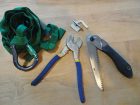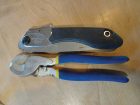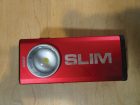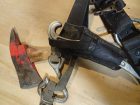
News
Trainer’s Corner: December 2018
During our last practice, I set the stage for the evolution to include two firefighters down. This, of course, was unexpected by the incident commander and it was interesting to see them deal with the situation. The two downed firefighters were both told to be unresponsive.
November 19, 2018
By
Ed Brouwer
It certainly stretched our members, but they were able to successfully rescue both firefighters.
During our debriefing, we touched on self-rescue techniques, specifically reminding our members about their pocket tools.
When we do Saving Our Own Hands-on Training, our instructors will usually get the firefighters to don their PPE and then request they empty their pockets.
The results vary from everything you can imagine to nothing whatsoever.
I’ve asked those firefighters carrying nothing if they actually know the purpose of those big pockets on their bunker gear. One group of firefighters indicated that their department didn’t allow them to carry tools in their pockets, fearing it would make holes in the gear.
I could have just told them to let it go, but I told them that it’s their gear, it is fitted to them, and it is their protection. A tool in their pocket could very well save their life, or the lives of their fellow firefighters.
Imagine being hooked by a piece of wire that could easily be cut by a pair of wire cutters – but alas they are in the tool box on the truck. Now it becomes a rapid intervention team, or RIT situation, and more firefighters are put at risk.
There is no honour in a line-of-duty death that could have been prevented by carrying a $14 pair of cutters, whether or not they wear a hole in the gear.
There are different schools of thought regarding what equipment should be carried in your bunker gear.
The most popular items include webbing, carabineers, extra gloves, first responder knife, door chocks, extra flashlight, pliers, lineman, cable cutter, wire cutter, side cutter, battery cable cutter, channel lock, and vice-grips.
It seems a large number of firefighters carry Leatherman tools or multi-tools, even Swiss army knives. But, I wonder how many have actually used them in a fire? These small tools are awkward to open and work with at the best of times, let alone with gloves on in poor light.
After deciding what you need to carry, the next question is where?
Realtors say, “Location, location, location.” In this case, location is everything.
Think about trying to get at your wire cutters while wearing SCBA and laying on your side.
Some firefighters keep structure tools such as wedges and webbing on the right side, and auto-extrication tools such as seatbelt cutters, Res-Q-Rench and window punch on the left.
Bunker pant pockets usually carry hand protection, rope, utility gloves and more webbing.
One firefighter carried an extra Nomex Hood for filter breathing during SCBA failure. This is not a good idea. Firefighters with SCBA malfunction or failure have a better chance of being revived if they keep their masks on.
Inhaling even a trace amount of super-heated fire gases may cause your larynx to close off, thereby robbing you of breath. Air management and calling a Mayday early give you the best chance of survival.
One firefighter suggested carrying an electrical tester. Although this may help during the investigation stage, in the heat of battle treating wires as being live is your best bet for survival.
During fire ground operations, an entanglement emergency can occur when a firefighter becomes caught up in debris that prevents freedom of movement, thus creating a potentially life-threatening incident.
Debris that can create an entanglement emergency include television and computer cables, electrical and telephone wiring, suspended ceiling grid and wiring, HVAC flexible tube and aluminum ductwork, draperies, blinds and more.
The number one thing you should have in your pockets is an extra flashlight. Be sure to check your backup flashlight each practice night. I wear my primary flashlight on my bunker coat. I found my helmet-mounted light was poor at best. It is a snag point during confined space operations.
There are a variety of door wedges being carried. Being able to ensure that the door you just opened stays open could mean the difference between life and death.
Door wedges can also be used to stop sprinkler heads. I found that the plastic wedges slip out of position easily. The wooden ones are a bit better, but the best is our homemade steel ones. A piece of one-inch angle iron cut into one-and-a-half-inch pieces with a quarter-inch steel rod hook welded to it works the best. Simply hang the hook over the hinge of the opened door and the angle iron keeps the door from closing.
I don’t carry vice-grips, but several firefighters swear by them. They use them to loosen or tighten bolts, as a door wedge, or they clamp them on an overhead door track to keep the door from coming down.
I carry two different lengths of webbing – 12 feet (looped to six feet) of one-inch webbing tied with a water knot attached to a four-and-a-half-inch aluminum carabineer and a 20-foot (looped) piece also tied with a water knot and attached to a four-and-a-half-inch aluminum carabineer. They can be used separately or hooked together for longer reach. Their main purpose is for self-rescue and RIT operations. Other uses include carrying tools and lowering and raising tools.
There are some special items for motor vehicle accidents – a spring-loaded centre punch for popping windows and heavy-duty cutters for battery cables. A multi-tool, including seat belt cutter, is also very useful. I carry a pocket mask in its case in my inner coat pocket. I also carry a small notebook and pen and readers.
For structure fires, I carry two steel door chocks, one plastic door chock, two door-latch stoppers made from a piece of inner tube with two one-and-a-half-inch holes cut in. You stretch one hole over the door knob, pull the inner tube over the latch and hook the second hole over the door knob on the other side of the door. Should that door close, it can’t latch because of the inner tube. I also carry a piece of chalk for marking interior doors after a search is complete.
My favourite tools include a folding saw and HD wire cutters. The wire cutters are nine and a half inches long with insulated handles. They have an incredibly powerful two-and-a-quarter-inch bite. These were around $14 at Canadian Tire.
My wife bought me the Pocketboy Folding Saw for Christmas more than 20 years ago. It is lightweight with a seven-inch micro blade that cuts through a two-by-four stud in seconds. I’ve never needed to use it, but I sure appreciate her thoughtfulness.
Just recently, I picked up a new second flashlight. The SLIM flashlight is manufactured by Nebo and brother does it pack a punch. It’s the best flashlight I have ever purchased. It produces an unbelievably strong light.
That sums up the possibilities for your carry-on equipment with one exception, the helmet. This is another place that firefighters carry stuff.
Personally, I don’t carry anything on my helmet, but I do carry two things in my helmet – my accountability nametags and a photo of my family. It just keeps it all in perspective for me.
Although it has been 15 years since I officiated the celebration of life for a retired NVFD training officer, I still have his old fire department utility belt that was given to me by his now-deceased widow.
The old leather belt, complete with fire axe and hose irons, hangs in my office. But, every time I see it I wonder why we got away from wearing them.
I have always thought the more tools we have at hand the better our chances of survival.
Certainly, no tool left on the truck has ever saved a firefighter’s life.
Until next time, stay safe and please remember to train like your life depends on it because it does.
Ed Brouwer is the chief instructor for Canwest Fire in Osoyoos, B.C., deputy chief training officer for Greenwood Fire and Rescue, a fire warden, wildland urban interface fire-suppression instructor and ordained disaster-response chaplain. Contact Ed at aka-opa@hotmail.com.
Print this page



